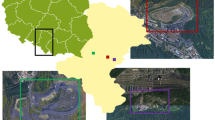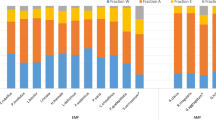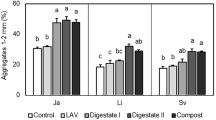Abstract
ATTENTION has been directed to the paramount importance of studying the substrate relationships of soil-inhabiting fungi1. The incorporation of organic matter into the soil provides a series of habitats which become colonized by the microfauna and microflora present in the soil. On plant remains, a succession of fungi can be traced from the early colonizers, the ‘sugar fungi’, to those species able to grow on the residual debris2. This residual debris contains a large percentage of cellulose3, together with lignin, hemicelluloses and other polysaccharides. The techniques most commonly used for isolating soil fungi frequently miss the species responsible for breaking down these important residual constituents, which are more slowly utilized than simple sugars, and in which, therefore, the active fungal colonizers may be growing for a comparatively long time. The ‘sugar fungi’ grow veiy rapidly on new material and then fade away when their very accessible fraction of the substrate has been utilized. Such fast-growing, heavily sporing species normally dominate the scene in routine investigations of soil fungi, unless methods selective for particular groups of fungi are used.
This is a preview of subscription content, access via your institution
Access options
Subscribe to this journal
Receive 51 print issues and online access
$199.00 per year
only $3.90 per issue
Buy this article
- Purchase on Springer Link
- Instant access to full article PDF
Prices may be subject to local taxes which are calculated during checkout
Similar content being viewed by others
References
Chesters, C. G. C., Trans. Brit. Mycol. Soc., 30, 100 (1948).
Burges, A., Broteria, 8, 64 (1939).
Halliwell, G., Nutr. Abs. and Rev., 29, 747 (1959).
Tribe, H. T., Seventh Symp. Soc. Gen. Microbiol., 287 (1957).
Sanborn, J. R., J. Bact., 14, 395 (1927).
Hungate, R. E., Bact. Rev., 14, 1 (1950).
Hazra, A. K., Bose, S. K., and Guha, B. C., Sci. and Cult., 24, 39 (1958).
Warcup, J., Nature, 166, 117 (1950).
Halliwell, G., Biochem. J., 79, 185 (1961).
Reese, E. T., App. Microbiol., 4, 39 (1956).
Author information
Authors and Affiliations
Rights and permissions
About this article
Cite this article
EGGINS, H., PUGH, G. Isolation of Cellulose-decomposing Fungi from the Soil. Nature 193, 94–95 (1962). https://doi.org/10.1038/193094a0
Issue Date:
DOI: https://doi.org/10.1038/193094a0
This article is cited by
-
The Faces of Fungi database: fungal names linked with morphology, phylogeny and human impacts
Fungal Diversity (2015)
-
Cloning of an intronlesscre1 gene fromChaetomium thermophilum
Annals of Microbiology (2009)
-
Purification and Characterization of a Xylanase Produced by Chaetomium thermophile NIBGE
World Journal of Microbiology and Biotechnology (2006)
-
Taeniolella rudis and Taeniolella longissima sp. nov. with secondary sympodioconidia from freshwater habitats
Mycoscience (2002)
-
Mycelium growth kinetics and optimal temperature conditions for the cultivation of edible mushroom species on lignocellulosic substrates
Folia Microbiologica (2001)
Comments
By submitting a comment you agree to abide by our Terms and Community Guidelines. If you find something abusive or that does not comply with our terms or guidelines please flag it as inappropriate.



